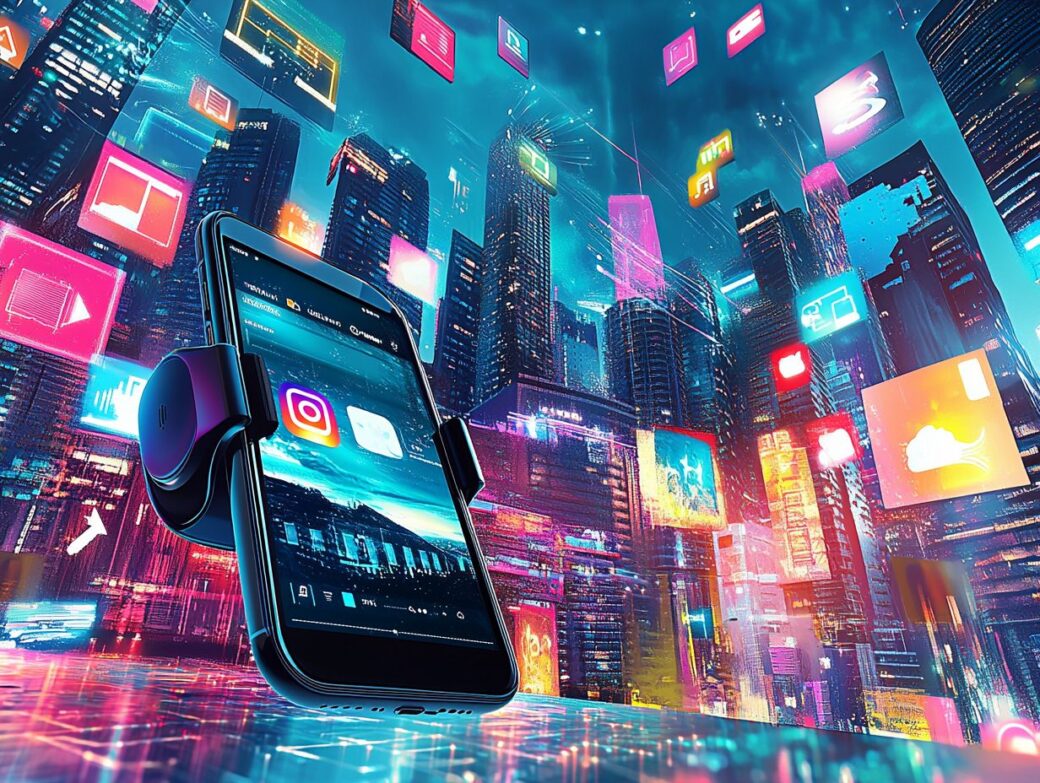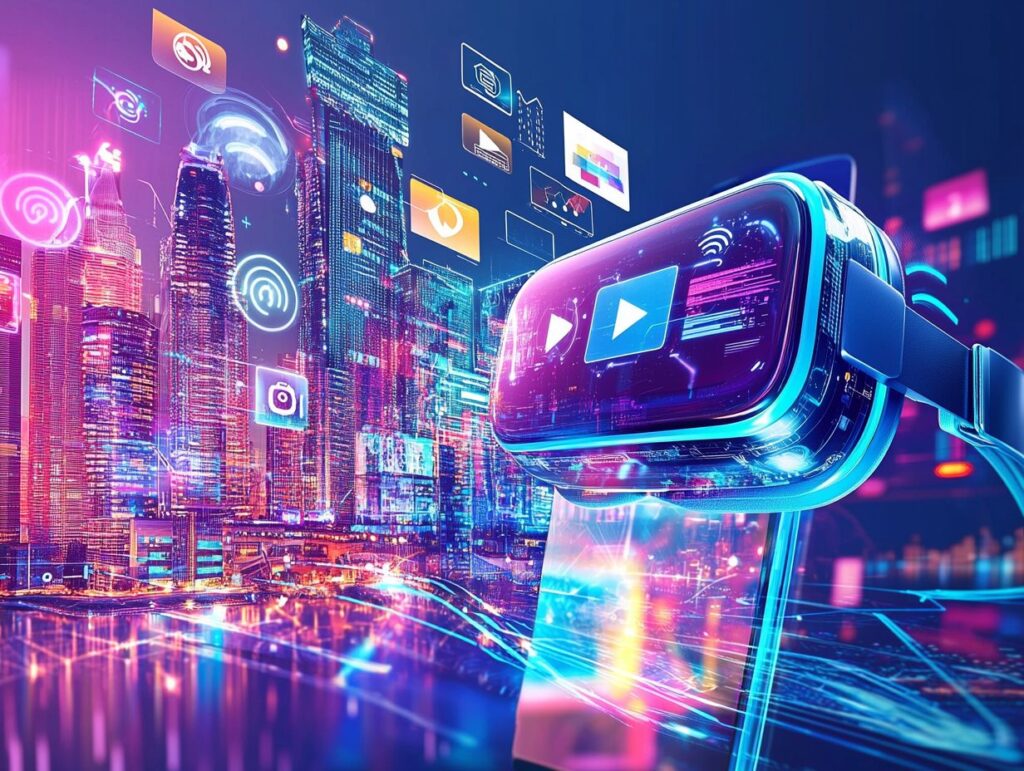Top Entertainment Media Trends In 2025: Streaming, Social & Beyond

In today’s rapidly evolving digital landscape, the entertainment media sector is experiencing a significant transformation within the entertainment business. The emergence of streaming services presents both challenges and opportunities for traditional media, as online platforms redefine audience engagement. Social media platforms have gained considerable influence, shaping audience engagement with content through effective marketing strategies and user-generated contributions. Additionally, emerging technologies such as virtual reality and AI are redefining the overall entertainment experience. As consumer behaviors increasingly lean towards greater diversity and inclusivity, it is imperative for industry stakeholders to comprehend these trends in order to successfully navigate the future of entertainment.
Key Takeaways:
- Streaming services will continue to dominate the entertainment industry in 2025, with platforms like Netflix, Hulu, Disney+, and Paramount leading the way. Traditional media will need to adapt to stay relevant.
- The rise of social media has transformed the way entertainment is consumed, with influencer marketing and user-generated content becoming major players. Brands must utilize these platforms to reach and engage with audiences.
- The emergence of new technologies, such as virtual and augmented reality, and artificial intelligence, will shape the future of entertainment. Personalization and immersive experiences will become increasingly important for attracting and retaining viewers.

 Defining Entertainment Media
Defining Entertainment Media
Entertainment media encompasses a broad array of content formats and platforms that deliver information, storytelling, and engagement to diverse audiences. This includes traditional mediums such as television and film, as well as emerging streaming services like YouTube, Netflix, and Roku, which are significantly reshaping viewer habits and consumer preferences.
As the industry continues to evolve, the integration of digital ecosystems and the increasing advertising revenues generated from social platforms further underscore the necessity of comprehending consumer insights and media trends. The creative quality of content production remains a key driver of market competition within the entertainment sector, presenting both opportunities and challenges for various stakeholders.
The entertainment media landscape is progressively defined by the accessibility and convenience afforded by streaming platforms, which fundamentally transform the manner in which individuals consume content. These platforms not only offer a vast array of viewing options but also customize experiences based on user preferences and behaviors, indicating a considerable shift towards personalized programming. According to eMarketer, digital media now accounts for nearly two-thirds of consumers’ total media time, highlighting the impact of these personalized experiences.
As viewers interact with a range of formats-from short-form videos to full-length series-creators are compelled to innovate in more dynamic ways, leveraging social video to enhance content discovery. Advertisers are acutely aware of these consumer behaviors, utilizing data analytics to refine their campaigns and enhance engagement, thereby rendering consumer insights an invaluable asset in today’s entertainment ecosystem.
Streaming Services: The Future of Entertainment
Streaming services are fundamentally transforming the entertainment landscape, establishing themselves as the predominant method for content consumption and delivery.
Leading platforms such as Netflix, Disney+, and Amazon Prime are at the forefront of this evolution, offering subscription video-on-demand (SVOD) models while also exploring ad-supported tiers to provide a variety of viewing options.
This transition is not only altering audience engagement but also driving substantial revenue growth within the entertainment industry, as traditional pay television struggles to adapt to these hybrid business models. A recent publication by Statista highlights the impressive market forecast for SVOD services worldwide, underscoring their growing impact.
Furthermore, Connected TV (CTV) platforms are enhancing the viewer experience by integrating targeted advertising and personalized content delivery, contributing to revenue growth in global markets.
Overview of Popular Streaming Platforms
Popular streaming platforms such as YouTube, Netflix, Disney+, and Amazon Prime Video have significantly transformed the manner in which audiences access and consume media, offering a vast array of premium content tailored to diverse viewer preferences, including live sports and gaming.
Each platform adopts a unique approach to content delivery; for instance, YouTube emphasizes user-generated content and social video, while Netflix is renowned for its substantial investment in high-quality original programming.
Disney+ effectively captivates families with its iconic franchises, appealing to both nostalgic adults and inquisitive younger audiences. In contrast, Amazon Prime Video leverages its dual benefits by bundling video services with shopping memberships.
In this competitive landscape, platforms such as Twitch have gained considerable traction, particularly within the gaming community, by fostering real-time interaction and engagement with niche communities. Additionally, Spotify has expanded its offerings beyond music to include curated podcasts that attract a diverse array of listeners, ensuring that even niche audiences find engaging content aligned with their interests.
Collectively, these platforms are not merely altering viewing habits; they are revolutionizing the way creators connect with their audiences and how content is discovered globally.
Impact on Traditional Media

 Impact on Traditional Media
Impact on Traditional Media
The emergence of streaming services has profoundly influenced traditional media, necessitating a digital transformation that challenges established norms within the entertainment industry. As audiences increasingly gravitate towards on-demand content, traditional media outlets encounter intensified market competition, compelling many to revise their advertising strategies and enhance viewer experiences, considering operational spending and marketing costs, in order to maintain relevance.
This paradigm shift has resulted in a wave of mergers and acquisitions, as companies strive to improve their content catalogs and operational efficiencies in response to changing consumer preferences and expectations.
In this era of digital transformation, traditional networks are investigating various models, including subscription-based offerings and ad-supported streams or ad-supported tiers, to adjust to these new viewer behaviors. This shift not only changes the manner in which content is consumed but also redefines advertising practices; marketers are now utilizing data analytics to target audiences with unprecedented precision.
Consequently, the viewer experience is becoming increasingly personalized, enabling tailored content recommendations that enhance engagement. Concurrently, traditional media firms are reevaluating their distribution channels and partnerships, creating opportunities for collaboration that may lead to innovative content delivery methods while navigating the complexities of copyright and content ownership. According to research findings published in MDPI, adapting to these changes is essential for traditional media to thrive in the evolving landscape.
Social media has emerged as a crucial component in the entertainment industry, profoundly influencing audience engagement and shaping consumer preferences within digital ecosystems.
Platforms such as Meta, TikTok, and Instagram serve as fertile grounds for influencer marketing and brand collaborations, allowing creators to engage with niche communities and extend their reach to broader audiences.
Additionally, these platforms enable users to generate their own content, leading to the proliferation of user-generated content that complements traditional media and enhances interactive experiences. This evolution is redefining the ways in which entertainment is consumed and shared.
Influencer Marketing and Brand Collaborations
Influencer marketing has emerged as a highly effective strategy for brands aiming to engage specific audience segments via social media platforms, enhancing brand engagement and audience segmentation. By partnering with influencers, brands are able to establish authentic connections with their followers, leveraging the influencers’ reach and credibility to enhance targeted advertising efforts. This approach not only increases brand engagement but also capitalizes on the trust and relatability that influencers have cultivated within their communities.
In an environment where consumers are inundated with advertisements, influencers provide relatable voices that resonate more profoundly with audiences. Effective strategies for brand collaborations involve the careful selection of influencers whose values align with the brand’s ethos, as well as the utilization of tailored content that appeals to the preferences of the influencer’s audience.
For example, authentic storytelling through product usage not only presents the brand in a natural context but also encourages a genuine dialogue with potential customers. By comprehensively understanding the unique demographics of their followers, brands can design campaigns that align their messaging with the influencer’s audience, thus enhancing the likelihood of a positive reception and increased engagement.
This synergy benefits not only the brand’s visibility but also enhances the influencer’s credibility, resulting in a mutually advantageous situation for both parties involved.
Rise of User-Generated Content

 Rise of User-Generated Content
Rise of User-Generated Content
The emergence of user-generated content (UGC) has significantly transformed the entertainment landscape, facilitating meaningful engagement between audiences and brands. Social media platforms such as YouTube and TikTok enable users to create, share, and monetize their content, fostering a sense of community and interactivity that enhances brand engagement.
This paradigm shift enables brands to collect valuable consumer insights and encourages collaboration between audiences and creators, thereby enriching the overall viewer experience and media supply chains.
By leveraging the creativity and authenticity of their audiences, brands like Netflix and Disney can develop marketing campaigns that resonate more profoundly with consumers. Successful campaigns frequently highlight content produced by fans on platforms like YouTube and Spotify, effectively showcasing their enthusiasm and loyalty. This strategy not only enhances brand visibility but also amplifies word-of-mouth marketing on channels such as Roku and Amazon, as satisfied viewers naturally become advocates for the brand.
UGC fosters a participatory culture wherein the distinction between producers and consumers becomes increasingly blurred, leading to innovative collaborations through viral challenges or fan-made remixes. Consequently, the entertainment industry continues to evolve, ensuring that brand narratives are co-created with engaged communities, thereby solidifying a robust and interactive entertainment ecosystem.
Emerging Technologies in Entertainment
Emerging technologies, including virtual reality (VR), augmented reality (AR), and artificial intelligence (AI), are profoundly transforming the entertainment industry by providing innovative solutions for content production and enhancing viewer experiences on CTV platforms.
These technologies enable the development of interactive experiences that engage audiences in unprecedented ways, resulting in more personalized content that is tailored to individual preferences.
As the entertainment landscape evolves, the integration of these technologies is poised to redefine the methods through which stories are told and consumed across various platforms.
Virtual and Augmented Reality
Virtual reality (VR) and augmented reality (AR) represent transformative technologies that offer immersive and interactive experiences, significantly enhancing the consumption and production of content within the entertainment industry, including video entertainment. By creating 360-degree environments and overlaying digital content onto the real world, these technologies open new avenues for storytelling, particularly in sectors such as gaming and live sports, where audience engagement is critical.
Through these innovations, creators can craft narratives that not only captivate audiences but also enable unique participatory experiences. For instance, VR gaming titles like ‘Beat Saber’ on systems like Microsoft’s Xbox provide players with an exhilarating experience that promotes physical movement, allowing them to feel as though they are truly immersed in the game. Similarly, AR applications such as Pokmon GO have transformed outdoor exploration by integrating digital characters into the physical world, encouraging players to engage with their surroundings in innovative ways.
These applications not only enhance immersion but also redefine social interactions, as players share experiences and compete in virtual environments, thereby elevating overall viewer engagement.
Artificial Intelligence and Personalization

 Artificial Intelligence and Personalization
Artificial Intelligence and Personalization
Artificial intelligence (AI) is increasingly integral to the entertainment industry, particularly in the domains of personalization and content discovery. By analyzing consumer preferences and segmenting audiences, AI enables platforms to deliver customized recommendations that enhance the viewer experience and improve engagement with premium content.
This technology not only recommends shows and movies based on individual viewing habits but also anticipates user interests, thereby transforming the manner in which audiences interact with media, as seen with platforms like Samsung’s smart TVs. For instance, streaming services utilize sophisticated algorithms to analyze extensive datasets, identifying patterns in user behavior that inform their content libraries and marketing strategies.
This data-driven approach enables consumers to become active participants in shaping their entertainment experiences rather than merely receiving content passively. Furthermore, AI’s influence extends to content production, enabling creators to identify trending topics or genres, thereby optimizing development timelines and ensuring that new offerings align with market demand.
As engagement metrics evolve, marketing strategies must also adapt, paving the way for innovative campaigns that resonate more profoundly with targeted demographics.
Shifts in Consumer Behavior and Preferences
Changes in consumer behavior and preferences are profoundly impacting the entertainment industry, resulting in evolving viewing habits and shifting demographics.
Contemporary audiences are demanding greater diversity and inclusivity in the content they engage with, prompting a digital transformation on platforms like Meta that challenges traditional media narratives.
As consumers increasingly seek content that resonates with their experiences and identities, it is imperative for entertainment platforms to adapt in order to meet these rising expectations.
Changing Demographics and Viewing Habits
Changing demographics are significantly reshaping viewing habits, as audiences increasingly seek content that aligns with their individual experiences and preferences on services such as Canal+ and Tubi. The emergence of niche communities underscores the necessity for targeted content production, as platforms endeavor to serve diverse audience segments. This transformation necessitates a nuanced understanding of consumer preferences and the development of tailored viewing experiences that engage various demographic groups.
This shift in viewer mindset is compelling content creators and distributors to reevaluate their strategies, ensuring they produce not only mainstream narratives but also unique stories that reflect a wide array of cultural backgrounds and lifestyles. By analyzing trends within specific subgroups, platforms can create algorithms that offer more personalized recommendations, thereby fostering loyalty and encouraging active participation among users.
Effectively engaging with niche communities may involve collaborations with influencers who resonate with these groups, facilitating authentic connections and enhancing content visibility. As these communities continue to evolve, remaining attuned to their preferences will be essential for maintaining relevance and driving growth within the highly competitive landscape of digital media, including platforms like Whale TV.
Demand for Diversity and Inclusivity
The demand for diversity and inclusivity in entertainment content is increasingly prominent in contemporary consumer preferences, prompting significant shifts in content production and storytelling practices. Audiences are advocating for representation that accurately reflects the complexities of their identities, resulting in a wider range of narratives that engage and resonate with diverse viewers.
This demand not only enhances audience engagement but also compels companies to reassess their production strategies to foster a more inclusive media landscape.
For instance, platforms such as Netflix and Disney+ have made deliberate efforts to feature films and series that celebrate multiculturalism, exemplified by productions like ‘Black Panther’ and ‘Coco.’ These works reflect rich cultural narratives while appealing to global audiences.
These successful initiatives highlight the importance of integrating diverse stories that can enhance viewership and stimulate important conversations, similar to productions by Pixar and Marvel. As society calls for greater accountability in the depiction of varied identities, the entertainment industry acknowledges that authentic representation is not merely a trend but a fundamental element in engaging with a modern audience that prioritizes empathy and authenticity, much like the narratives in Star Wars by Paramount.






